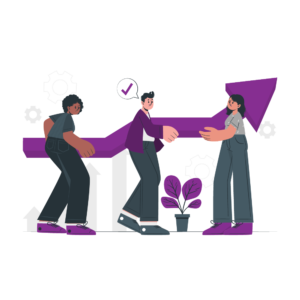
Change

How people value innovation. That may include ideas, teachings, or technologies that affect their daily life and processes.
Story: Electrifying Change
John: I’m thinking about getting an electric car. They’re environmentally friendly and much cheaper to run. What do you think?
Tom: I don’t know, I prefer gasoline cars. They’re easier to find fuel for, and I’m used to the sound and feel of the engine.
John: But think about the benefits. No more emissions or oil changes and the battery range keeps improving.
Tom: I don’t trust the batteries. They might not last as long as advertised, and recharging them takes a long time.
John: That’s true, but as technology advances, batteries will become more efficient, and charging stations will become more widespread. Plus, electric cars are already proven to have lower maintenance costs.
Tom: Maybe in a few years, when electric cars become more mainstream. They must prove themselves first.
John: I understand, but I believe innovation is the way forward. We need to embrace new technologies.
Tom: I hear you, but I’m more cautious about new things.

Why does it matter?
Examples from the Bible
- Jesus uses some citations from the Scriptures and redefines them. The religious leaders are not very excited about the change (Matthew 5:17-48).
- The Roman Centurion understood that Israel was central to God’s plan and that the Messiah was not a threat to Rome but the Savior of All the world. Even the Jews around him were slow to take faith steps like his: “Just say the word and my servant will be healed!” (Luke 7:1-10).
- Jesus uses the metaphor of new wine and new wineskins (Luke 5:37-38) to emphasize the need for receptivity to new teachings and ideas.
- God gave Israel the commandment to hold on to the law and not to deviate from it (Deuteronomy 6:4-9) because God is unchanging (Hebrews 13:8).
- The Apostle’s Council (Acts 15:1-31) settled the debate between traditional Jewish traditions regarding circumcision and Gentiles who joined the church.
- The philosophers in Athens were curious about Paul’s new teaching and invited him to speak. Paul brought a new message but used their traditions to bring transformation (Acts 17:16-34).
Real-life examples
- Once, a community development worker tried to teach local farmers new farming techniques that would be more sustainable and profitable. However, he got increasingly frustrated that people did not apply what he taught. One day, he invited the village elders to his house to discuss his frustrations. At his home, the elder saw his garden. They saw how much more food his plants produced and asked why he did not invite the farmers to his house to see it instead of just talking about it. Once the training was done on-site, the farmers slowly changed their techniques, and their farms became more profitable. Initially, they resisted the proposed change until they saw it in person. They were defensive about his “claims” but enlightened by his new techniques that could be quickly adopted.
- In Teheran, young people are being forced to live by the traditions of their leaders. Many young people are embracing different values than the older generation. This is causing conflicts and even violent protests.1
Relevance

The Kingdom of God always demands change, reorientation, and transformation. Only when we know how people generally think about and respond to new ideas and concepts can we engage them to transform worldviews, beliefs, attitudes, and behaviors.
In every culture, young people are more open to new ideas. At the same time, the older generation is more inclined to hold on to traditions. This generational difference must also be considered.
Orality preference continuum
Every culture is in constant change. How change is perceived is a differentiating factor in HOR and LOR cultures.
Oral cultures generally uphold their traditions but are influenced by Western innovation. New ideas and innovation can be seen as a threat to established ways of life.
Innovation-loving cultures also generally value youth more than experience (this ties it to the orality trait of respect). LOR cultures usually are more progress-embracing than HOR cultures.
The examples below will help better understand change in cultures that fall somewhere between both extremes.
| Very high | High | Low | Very low |
|---|---|---|---|
| Our traditions, beliefs, and practice are WHO we ARE. To change means we are no longer “us.” | Innovations are born out of necessity and approved by the elders. | Innovation happens often, but it has checks and balances. | Innovations come out of helpful research and development. |
| Our tried and generationally adopted practices are next to sacred and not to be changed. | Our traditional ways are the foundation of communal life. Still, they can be adapted to fit the times to enhance what we already have in place. | New ideas and practices usually improve our status quo but must be demonstrated first. | New innovations are quickly embraced even if not thoroughly proven. |
What has been discovered?
Diffusion of Innovations: Introducing community change requires knowing who influences others and who among those influencers is willing to adopt new things more quickly than others.2
To promote change or cling to tradition, positive deviance usually works best for long-term change: showing people positive examples of adopting non-traditional thoughts and practices.3
Tradition was the name given to those cultural features which, in situations of change, were to be continued to be handed on, thought about, preserved, and not lost. Many cultures elevate this to a primary value of who they are as a people.4
Creativity is often seen as the tension pulling on tradition in culture.5
African development values traditions as indigenous peoples make their way forward through their choices and values.6

Additional resources
- Discover more about Change through our training materials at Orality.Academy!
- Uytanlet, Juliet Lee. The Hybrid Tsinoys: Challenges of Hybridity and Homogeneity as Sociocultural Constructs among the Chinese in the Philippines. American Society of Missiology Monograph Series 28. Eugene, Oregon: Pickwick Publications, 2016.
- Shahram Khosravi, Young and Defiant in Tehran, Contemporary Ethnography (Philadelphia: University of Pennsylvania Press, 2008). ↩︎
- Rogers, E. M., Singhal, A., & Quinlan, M. M. (2014). Diffusion of innovations. In An integrated approach to communication theory and research (pp. 432-448). Routledge. ↩︎
- Dearing, J. W., & Singhal, A. (2020). New directions for diffusion of innovations. ↩︎
- Costin, Cathy Lynne and Michael C. Ennis-McMillan, Co-Editors. Open Anthropology. Creativity and Innovation: Anthropological Perspectives. July 2020: 9(2) 1-11.
July 2021 https://www.americananthro.org/StayInformed/OAArticleDetail.aspx?ItemNumber=26322 ↩︎ - Costin, Cathy Lynne and Michael C. Ennis-McMillan, Co-Editors. Open Anthropology. Creativity and Innovation: Anthropological Perspectives. July 2020: 9(2) 1-11.
July 2021 https://www.americananthro.org/StayInformed/OAArticleDetail.aspx?ItemNumber=26322 ↩︎ - Nkwi, Paul Nchoji. The Ethnography of development: an African anthropologist’s vision of the development process. In, The Cultural dimensions of global change: an anthropological approach, 1996: p. 217-243. ↩︎
